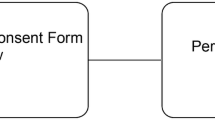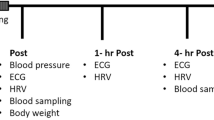Abstract
The principal objective of this paper is basic research on the development of methods for the prevention of chronic fatigue. Overtraining was paid special attention to as one of the types of chronic fatigue condition. Six healthy male participants in a distance-running competition were recruited and used as subjects for this study with informed consent for all examinations. Subjects, that is, participants in the competition, tried to achieve their objective maximum running distance designated before the competition during one month, while in the same period performing their routine work duties. It was reported that the competition caused participants to exhibit an overtrained condition. In this paper, effects of endurance running during one month on blood properties and the fatigue level felt by the subject (subjective fatigue) were studied.
Examinations carried out in this research were as follows; 1) physical examination was conducted 3 times during the study; 1 week before the competition, immediately before and 3 weeks after the end of the competition, 2) blood sampling was conducted 4 times; prior to the competition, 1 week after the beginning of and immediately before the end of the competition, and about 3 weeks after the competition, 3) subjective fatigue levels were monitored 8 times; 1 week before and one time in every week during the competition, and 1 week and again 3 weeks after the competition.
Immediately before the end of the competition, when subjects might be expected to exhibit the overtrained condition, minor influences on fatigue levels were found. However, effects of the endurance run seemed to remain more than 3 weeks after the competition as indicated by changes of the population of white blood cells and blood hormone levels.
The above mentioned results suggest that it is important to determine signs of overtraining at an early stage. To determine overtraining at an early stage, norepinephrine, testosterone and the ratio of testosterone to cortisol may be the most useful indices. These, as well as the element of “drowsiness and dullness” in the questionnaire on subjective symptoms of fatigue authorized by the Japan Association of Industrial Health and the elements of “anger”, “fatigue”, and “confusion” in the Profile of Mood State (POMS) questionnaire are thought to be the most important subjective indices.
Similar content being viewed by others

References
Potempa KM. Chronic fatigue. Annu Rev Nurs Res 1993;11: 57–76.
Shiroyama M. Overtraining syndrome. Jpn J Phys Fitness Sports Med 1996;45: 395–8.
Kawahara T. Prevention and policy against overtraining. J Clin Sports Med 1992;9: 489–95.
Hooper SL, Mackinnon LT. Monitoring overtraining in athletes. Recommendations. Sports Med 1995;20: 321–7.
Budgett R. The overtraining syndrome. BMJ 1994;309: 465–8.
Lehmann M, Dickhuth HH, Gendrisch G, Lazar W, Thum M, Kaminski R, Aramendi JF, Peterke E, Wieland W, Keul J. Trainingovertraining. A prospective, experimental study with experienced middle- and long-distance runners. Int J Sports Med 1991 ;12: 444–52.
Ferry A, Picard F, Duvallet A, Weill B, Rieu M. Changes in blood leucocyte populations induced by acute maximal and chronic submaximal exercise. Eur J Appl Physiol 1990;59: 435–42.
Benoni G, Bellavite P, Adami A, Chirumbolo S, Lippi G, Brocco G, Giulini GM, Cuzzolin L. Changes in several neutrophil functions in basketball players before, during and after the sports season. Int J Sports Med 1995;16: 34–7.
Pyne DB, Baker MS, Fricker PA, McDonald WA, Telford RD, Weidemann MJ. Effects of an intensive 12-wk training program by elite swimmers on neutrophil oxidative activity. Med Sci Sports Exerc 1995;27: 536–42.
Ndon J, Snyder AC, Foster C, Wehrenberg WB. Effects of chronic intense exercise training on the leukocyte responese to acute exercise. Int J Sports Med 1992;13: 176–82.
Kogi K, Saito Y, Mitsuhashi T. Validity of three components of subjective fatigue feelings. J Science Labour 1970;46: 251–70.
McNair DM, Lorr M, Droppleman LF. Profile of Mood States Manual. San Diego: Educational and Industrial Testing Service, 1971.
Yamamoto K. POMS as an index of evertraining. J Clin Sports Med 1990;7: 561–5.
Frazier SE. A comparison of team mood state profiles utilizing the mental health model. J Human Movement Studies 1989;16: 91–9.
Kurimori S, Oka T, Kakizaki T. Evaluation of mental stress and fatigue induced by performance of a mental task. 2. An experiment in 11-h self-paced calculating task. Jpn J Ind Health 1994;36: 9–15.
Nagamine S, Suzuki S. Anthropometry and body composition of Japanese young men and women. Hum Biol 1964;36: 8–15.
Carruthrs M, Taggart P, Conway N, Bates D, Somerville W. Validity of plasma-catecholamine estimations. Lancet 1970; (2): 62–7.
Kanai I. Manual of Clinical Laboratory Methods. In: Kanai M, editor. Tokyo: Kanehara Shuppan Co. Ltd., 1994.
Adlercreutz H, Harkonen M, Kuoppasalml K, Naverl H, Huhtaniemi I, Tikkanen H, Remes K, Dessypris A, Karvonen J. Effect of training on plasma anabolic and catabolic steroid hormones and their response during physical exercise. Int J Sports Med 1986;7: s27–8.
Hanson P. Overtraining syndrome (staleness). In: Strauss RH, editor. Sports Medicine. Philadelphia: W. B. Saunders, 1984: 87–90.
Yoshimura H. Anemia during physical training (sports anemia). Nutrition Reviews 1970;28: 251–3.
Hooper SL, Mackinnon LT, Howard A, Gordon RD, Bachmann AW. Markers for monitoring overtraining and recovery. Med Sci Sports Exerc 1995;27: 106–12.
Pyne DB. Regulation of neutrophil function during exercise. Sports Med 1994;17: 245–58.
Butcher EC. The regulation of lymphocyte traffic. Curr Top Microbiol Immunol 1986;128: 85–92.
Suzuki K, Naganuma S, Mochizuki M, Shiraishi M, Nakaji S, Sugawara K, Totsuka M, Sato K. Differential patterns of the number and proportion of blood leukocytes following endurance exercise of moderate, strenuous and severe conditions. 1995;50: 631–6.
Kjaer M. Epinephrine and some other hormonal responses to exercise in man: With special reference to physical training. Int J Sports Med 1989;10:2–5.
Tønnesen E, Christensen NJ, Brinkløv MM. Natural killer cell activity during cortisol and adrenaline infusion in healthy volunteers. Europ J Clin Invest 1987;17: 497–503.
Weicker H, Werk E. Interaction between hormones and the immune system. Int J Sports Med 1991;12: s30–7.
Smith JA, Telford RD, Mason IB, Weiderman MJ. Exercise, training and neutrophil microbicidal activity. Int J Sports Med 1990;11: 179–87.
Fitzgerald L. Overtraining increases the susceptibility to infection. Int J Sports Med 1991;12:s5–8.
Haslett C, Savill JS, Meagher L. The neutrophil. Current Opin. Immunol 1989;2: 10–8.
Kappel M, Tvede N, Galbo H, Haahr PM, Kjaer M, Linstow M, Klarlund K, Pedersen BK. Evidence that the effect of physical exercise on NK cell activity is mediated by epinephrine. J Appl Physiol 1991;70: 2530–4.
Fry RW, Grove JR, Morton AR, Zeroni PM, Gaudieri S, Keast D. Psychological and immunological correlates of acute overtraining. Br J Sp Med 1994;28: 241–6.
Kindermann W, Shanabel A, Schmitt WM, Biro G, Cassens J, Weber F. Catecholamines, growth hormone, cortisol, insulin, and sex hormones in anerobic and aerobic exercise. Eur J Appl Physiol 1982;49: 389–99.
Nosaka K, Clarkson PM. Muscle damage following repeated bouts of high force eccentric exercise. Med Sci Sports Exerc 1995;27: 1263–9.
Lehmann M, Foster C, Keul J. Overtraining in endurance athletes: A brief review. Med Sci Sports Exer 1993;25: 854–62.
Author information
Authors and Affiliations
Rights and permissions
About this article
Cite this article
Kumae, T., Kawahara, T. & Uchiyama, I. A study for prevention of chronic fatigue Part 1. Effects of endurance running during one month on blood properties and subjective fatigue. Environ Health Prev Med 2, 21–27 (1997). https://doi.org/10.1007/BF02931225
Received:
Accepted:
Issue Date:
DOI: https://doi.org/10.1007/BF02931225



